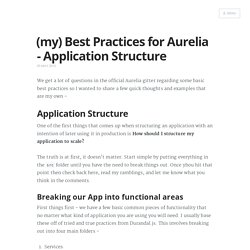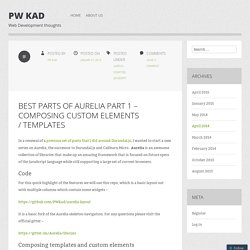Zoom
Trash

Aurelia : un sérieux concurrent à AngularJS ? Ce framework JavaScript MV* est le successeur du framework Durandal. Aurelia : un sérieux concurrent à AngularJS ?

Ce framework JavaScript MV* est le successeur du framework Durandal Il y a quelques mois encore, Rob Eisenberg faisait partie de l'équipe de développement d'Angular. Il a ensuite décidé de la quitter pour travailler sur son propre framework au sein de sa startup Durandal. Le résultat est maintenant dévoilé en preview et porte le doux nom d'Aurelia. Son créateur le décrit comme un framework de la prochaine génération, successeur de Durandal, le framework qu'avait déjà créé la boîte du même nom. Aurelia est un framework JavaScript client de type MV* (Model, View, et ce que vous voulez pour relier les deux), gratuit et open-source, écrit avec les dernières spécifications EcmaScript 6 et 7 (noté ES6/7 et encore à l'étude, rappelons-le). Le framework ne nécessite pas de dépendances et s'avère très modulaire, décomposé en différents composants indépendants et relativement simples. Parmi sa longue liste de fonctionnalités, on peut citer : Et vous ?
(my) Best Practices for Aurelia - Application Structure. We get a lot of questions in the official Aurelia gitter regarding some basic best practices so I wanted to share a few quick thoughts and examples that are my own - One of the first things that comes up when structuring an application with an intention of later using it in production is How should I structure my application to scale?

The truth is at first, it doesn't matter. Start simple by putting everything in the src folder until you have the need to break things out. Once yhou hit that point then check back here, read my ramblings, and let me know what you think in the comments. Breaking our App into functional areas First things first - we have a few basic common pieces of functionality that no matter what kind of application you are using you will need. Services Models Templates (Widgets) Configs (optional) Services Sample structure - - /app | -- /services | -- /dataservices | -- session.js | -- datacontext.js | -- /models | -- /templates | -- /configs Models.
Best Parts of Aurelia Part 1 – Composing custom elements / templates. In a renewal of a previous set of posts that I did around Durandal.js, I wanted to start a new series on Aurelia, the successor to Durandal.js and Caliburn.Micro.

Aurelia is an awesome collection of libraries that make up an amazing framework that is focused on future specs of the JavaScript language while still supporting a large set of current browsers. Code For this quick highlight of the features we will use this repo, which is a basic layout out with multiple columns which contain some widgets – It is a basic fork of the Aurelia skeleton-navigation. For any questions please visit the official gitter – Composing templates and custom elements What’s the difference between using the compose element vs a custom elements? Compose: Can be used to dynamically compose templates (not forced to define the template type)Can use same view model but different view for each item in an arrayYou can separate your views and view models into the smallest bits of (re-usable) code needed. Custom element: QuiestJ-leBlog - Veille techno d'un étudiant en informatique.
Aurelia.io. Aurelia.io est un tout nouveau framework javascript basé sur jspm développé par l'auteur de Durandal.

Ce framework est très prometteur et je suis prêt à miser sur lui en tant que prochain framework de référence front. Le meilleur des meilleurs frameworks web Aurelia.io propose donc un environnement de base construit autour de jspm et ES6. Il est évidemment possible d'utiliser Bower à la place de jspm et n'importe quel meta langage à la place de ES6 (coffee, typed, ou même ES5) mais il a été conçu pour ES6.
Cet aspect du framework rappelle donc Dart, le langage de Google visant à remplacer Javascript par un langague plus proche de Java. Au premier abord, on sent l'inspiration venir d'Angular avec ses templates et ses two-ways binding. Et pour finir, on va aussi retrouver un aspect d'AngularJS : l'injection de dépendances. Simplicité du code Je vous passe les détails du bootstraping d'une application, il vous suffira de suivre le tutorial pour en savoir plus. <template><p>Hello ${name}! Aurelia.